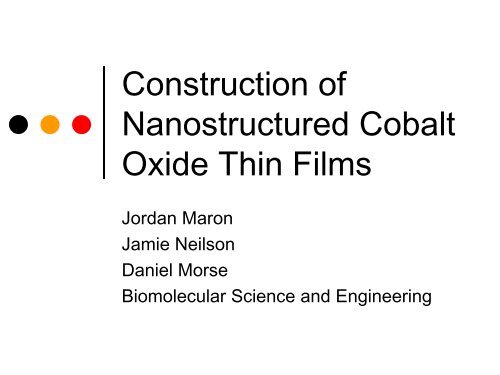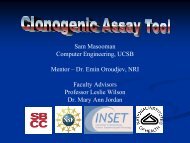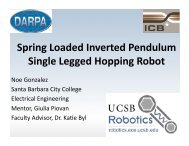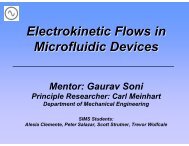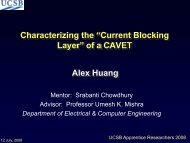Construction of Nanostructured Cobalt Oxide Thin Films
Construction of Nanostructured Cobalt Oxide Thin Films
Construction of Nanostructured Cobalt Oxide Thin Films
You also want an ePaper? Increase the reach of your titles
YUMPU automatically turns print PDFs into web optimized ePapers that Google loves.
<strong>Construction</strong> <strong>of</strong><br />
<strong>Nanostructured</strong> <strong>Cobalt</strong><br />
<strong>Oxide</strong> <strong>Thin</strong> <strong>Films</strong><br />
Jordan Maron<br />
Jamie Neilson<br />
Daniel Morse<br />
Biomolecular Science and Engineering
Why Study <strong>Cobalt</strong> <strong>Oxide</strong><br />
Energy application: photocatalytic water<br />
splitting – generating hydrogen fuel from light<br />
2H 2 O 2H 2 + O 2<br />
light<br />
Co 3 O 4<br />
Enabled by:<br />
<strong>Cobalt</strong> <strong>Oxide</strong><br />
Powder<br />
• Atomic structures with Co(III), e.g. Co 3 O 4<br />
• Morphology with high surface area<br />
<strong>Cobalt</strong> <strong>Oxide</strong><br />
Atomic Structure
<strong>Cobalt</strong> <strong>Oxide</strong> Background<br />
Usually produced with irregular<br />
morphology and microstructure<br />
• Hard to characterize<br />
Our method <strong>of</strong> synthesis allows for<br />
control <strong>of</strong> morphology on the nano<br />
scale<br />
• More useful for proposed applications
My Project Goal<br />
Find which cobalt counter ion and<br />
annealing temperature produce the<br />
most crystalline cobalt oxide sample<br />
with the highest specific surface area<br />
derived from a nanostructured<br />
architecture
Experimental Methods<br />
<br />
<br />
<br />
Synthesize cobalt hydroxide by reacting various CoA x<br />
precursors with ammonia via vapor diffusion<br />
• <strong>Cobalt</strong> chloride<br />
• <strong>Cobalt</strong> perchlorate<br />
• <strong>Cobalt</strong> sulfate<br />
• <strong>Cobalt</strong> iodide<br />
Sample Treatment:<br />
• One substrate left as is<br />
• One put in 180°C oven<br />
• One put in 500°C furnace<br />
• One put in 800°C furnace<br />
Analysis and characterization
Experimental Methods Visual<br />
Start<br />
Finish
Characterization<br />
Two machines are used<br />
• X-Ray diffractometer<br />
• Scanning electron microscope<br />
Used to identify compound and<br />
analyze its morphology
X-Ray Diffraction<br />
Control: Alfa Aesar cobalt oxide
X-Ray Data Continued<br />
<strong>Cobalt</strong> chloride precursor<br />
Quartz<br />
Amorphous<br />
Amorphous<br />
<strong>Cobalt</strong> Hydroxide
X-Ray Data Continued<br />
<strong>Cobalt</strong> perchlorate precursor<br />
<strong>Cobalt</strong> Hydroxide<br />
Both <strong>Cobalt</strong> <strong>Oxide</strong><br />
Amorphous
Scanning Electron<br />
Microscopy<br />
Control: Alfa Aesar cobalt oxide<br />
Relatively unstructured morphology
SEM Data Continued<br />
<strong>Cobalt</strong><br />
chloride<br />
precursor<br />
Individual platelets<br />
at all temperatures<br />
Notice strange Swisscheese<br />
platelet<br />
morphology in 900°C<br />
sample
SEM Data Continued<br />
Varying morphology<br />
at all temperatures<br />
<strong>Cobalt</strong><br />
perchlorate<br />
precursor<br />
Very interesting porous<br />
nanostructure - cause<br />
unknown
Results Summary<br />
Precursor Salt As Prepared 180°C 500°C 800°C<br />
Chloride α Co(OH) 2<br />
Platelets<br />
Amorphous<br />
Platelets<br />
Amorphous<br />
Platelets<br />
N/A (900°C)<br />
Porous<br />
platelets<br />
Perchlorate α Co(OH) 2<br />
Web<br />
Amorphous<br />
Web<br />
Co 3 O 4<br />
Porous<br />
nanostructure<br />
Co 3 O 4<br />
Pillar<br />
nanostructure<br />
Sulfate α Co(OH) 2<br />
Web<br />
α Co(OH) 2<br />
Web<br />
Amorphous<br />
Web<br />
Co 3 O 4<br />
Globular<br />
microstructure<br />
Iodide α Co(OH) 2<br />
Web<br />
Co 3 O 4<br />
Web<br />
Co 3 O 4<br />
Web<br />
Co 3 O 4<br />
Globular Web
Conclusions<br />
Both counter ion and annealing<br />
temperature determine material<br />
properties:<br />
• Determines morphology<br />
• Crystal orientation<br />
• Atomic structure<br />
Larger counter ions decrease annealing<br />
temperature needed and increases<br />
microporosity
Future Exploration<br />
Perform a second trial with each precursor<br />
to see whether or not the results can be<br />
reproduced or improved<br />
Investigate causes <strong>of</strong> certain morphologies<br />
Test performance <strong>of</strong> our cobalt oxide and<br />
compare to that <strong>of</strong> commercially available<br />
cobalt oxide<br />
Analyze with transmission electron<br />
microscope<br />
Measure specific surface area
Reflections<br />
I got a taste <strong>of</strong> what it is like to do graduate research in<br />
a real laboratory<br />
I confirmed for myself that pursuing a career in the<br />
sciences seems to be the right path for me take<br />
I loved getting to use all the really fancy equipment
Acknowledgements<br />
Jamie Neilson and Birgit Schwenzer for being my<br />
mentors<br />
Pr<strong>of</strong>essor Daniel Morse for allowing me to work in<br />
his department<br />
California NanoSystems Institute, Institute for<br />
Collaborative Biotechnologies, Department <strong>of</strong><br />
Energy, and National Science Foundation for funding<br />
the research<br />
Lubi, Anthony, and Herb for organizing the program
<strong>Construction</strong> <strong>of</strong><br />
<strong>Nanostructured</strong> <strong>Cobalt</strong><br />
<strong>Oxide</strong> <strong>Thin</strong> <strong>Films</strong><br />
Jordan Maron<br />
Jamie Neilson<br />
Daniel Morse<br />
Biomolecular Science and Engineering
X-Ray Data<br />
<strong>Cobalt</strong> sulfate precursor<br />
Notice consistency between trials<br />
<strong>Cobalt</strong> oxide confirmed in matching 800°C samples<br />
500°C contained one cobalt oxide peak<br />
As is and 180°C shown to contain cobalt hydroxide
SEM Data<br />
<strong>Cobalt</strong><br />
sulfate<br />
precursor<br />
Globule Morphology
X-Ray Data<br />
<strong>Cobalt</strong> iodide precursor<br />
Co 3 O 4<br />
Co 3 O 4<br />
Disordered Co 3 O 4<br />
<strong>Cobalt</strong> Hydroxide
SEM Data<br />
<strong>Cobalt</strong> iodide<br />
precursor<br />
Morphology resembles<br />
that <strong>of</strong> the 800°C<br />
sulfate sample
TGA Data<br />
Chloride Sample
TGA Data<br />
Perchlorate Sample
TGA Data<br />
Sulfate Sample
TGA Data<br />
Iodide Sample


